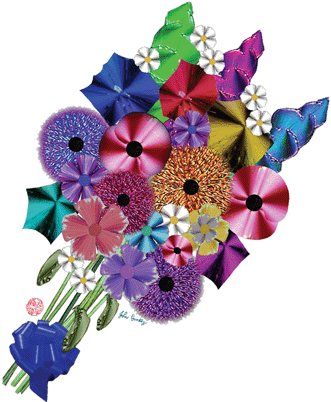Your new weekly
Abstract
This issue of the journal is a Celebration issue to launch the first of our weekly publications and also to mark 15 years of publication. Maurizio Prato and Graham McCann highlight the most important journal developments.
It is a mark of the success of Journal of Materials Chemistry and the community that it serves that the journal will be published weekly this year. The journal has undergone dramatic growth1 since its launch 15 years ago and it is this growth and the support of our authors and referees that have enabled us to move from monthly to weekly publication in the space of only two years. We hope that you will enjoy reading the journal every week and find the new format easier to read, both in print and on the web.
This celebration issue marks the 15th year of publication of the journal, which is a cause for celebration in itself. Members of the Editorial Boards, past and present, have contributed to the issue, which makes a superb showcase for the journal. Many thanks to all who have contributed; not only through publishing a paper in this issue but also through supporting the journal throughout its first 15 years. Thanks also to those whose articles could not be included in this issue and will appear in forthcoming issues. We would like to express our gratitude to John Goodby for presenting us with a celebration bouquet of liquid-crystal flowers: the image graces the cover of this issue.
In 2004 we launched two new types of review article: Applications2 and Highlights.3 These have been very popular and successful. We have also increased the number of reviews published substantially. A reviews web page is available from our journal homepage: www.rsc.org/materials.
Scope & service
The scope of the journal has changed slightly this year to emphasise the journal's breadth of coverage, which includes the design and synthesis of materials, their characterisation, processing, modelling, properties and applications. In addition to papers reporting the chemistry of materials, papers covering interdisciplinary research and papers from related disciplines are encouraged, in particular those addressing emerging and quickly developing fields.The criteria for acceptance of articles have also been clarified: papers must highlight the impact and significance of the work for a materials readership to establish the suitability of the article for Journal of Materials Chemistry. You can read our full Instructions for Authors on our web site.
The journal continues to offer the best service available to authors, particularly in providing by far the fastest1 and also the friendliest publication service available. 50% of the articles published over the last year are from groups in Europe, the next largest regions represented are then North America, Japan and China. These figures, shown graphically on this page, reflect the truly international profile of the journal. This year we have received articles from over 60 different countries.
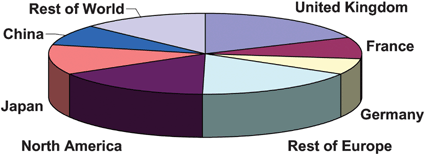 | ||
| Fig. 1 International authorship, J. Mater. Chem. | ||
New board members
We welcome three new Board members: Clément Sanchez (Paris) and Daoben Zhu (Chinese Academy of Sciences) who join the Editorial Board and Fred Wudl (University of California) who is a new member of the International Advisory Editorial Board. All three are profiled later in this issue. Professor Zhu has been appointed as Regional Associate Editor for China. His role is to represent the journal in China and also to represent the needs of authors from China on the Editorial Board. With a steady growth in submissions from China Professor Zhu's appointment is an important step in the future development of the journal.Phil Hodge and Stephen Mann have now reached the end of their terms on the Editorial Board. Many thanks for their hard work and enthusiasm during their time on the Board. In particular we would like to thank Stephen Mann for coordinating our latest, impressive Guest Editor Issue “New developments in bio-related materials”.4 Other themed issues in 2004 included Professor C. N. R. Rao's Guest Editor Issue “New developments in nanomaterials”5 and “From molecules to materials”, guest edited by Paul O'Brien and Alice Sullivan.6
Announcing Soft Matter
This summer, Journal of Materials Chemistry readers will benefit from free access to the print and online versions of the RSC's new interdisciplinary journal, Soft Matter. It will be a high quality journal publishing research into soft materials, including complex fluids, with a particular focus on the interface between chemistry and physics. It will provide a forum for the communication of the generic science underpinning the properties and applications of soft matter. To read more about the journal and to submit online visit www.softmatter.org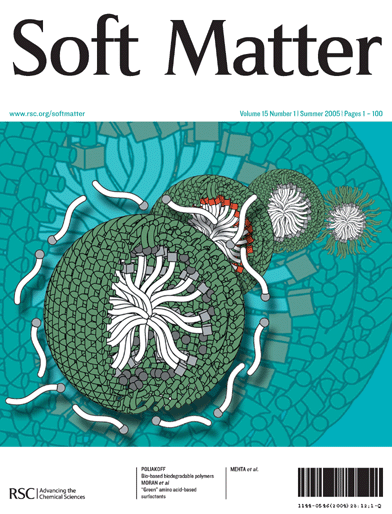 | ||
| Fig. 2 Launching summer 2005, www.rsc.org/softmatter. | ||
| Most accessed Communications7–11 | |
|---|---|
| • | Regioregular polythiophene/gold nanoparticle hybrid materials Lei Zhai and Richard D. McCullough |
| • | Novel one-step synthesis of amine-stabilized aqueous colloidal gold nanoparticles M. Aslam, Lei Fu, Ming Su, K. Vijayamohanan and Vinayak P. Dravid |
| • | Assembly of hollow spheres by templated liquid phase deposition following the principles of biomineralisation Holger Strohm and Peer Löbmann |
| • | Ultrawide ZnO nanosheets Jae-Hwan Park, Heon-Jin Choi, Young-Jin Choi, Seong-Hyung Sohn and Jae-Gwan Park |
| • | Density control of single-walled carbon nanotubes using patterned iron nanoparticle catalysts derived from phase-separated thin films of a polyferrocene block copolymer Sarah Lastella, Yung Joon Jung, Hoichang Yang, Robert Vajtai, Pulickel M. Ajayan, Chang Y. Ryu, David A. Rider and Ian Manners |
| Most Accessed Papers12–16 | |
|---|---|
| • | Self-organized novel morphologies of lamellar aluminophosphates James G. C. Shen |
| • | Ethylene glycol-mediated synthesis of metal oxide nanowires Xuchuan Jiang, Yuliang Wang, Thurston Herricks and Younan Xia |
| • | Thin film photonic crystals: synthesis and characterisation Martyn A. McLachlan, Nigel P. Johnson, Richard M. De La Rue and David W. McComb |
| • | Structural study by transmission and scanning electron microscopy of the time-dependent structural change in M41S mesoporous silica (MCM-41 to MCM-48, and MCM-50) Isabel Díaz, Joaquin Pérez-Pariente and Osamu Terasaki |
| • | Understanding the quantum size effects in ZnO nanocrystals Ranjani Viswanatha, Sameer Sapra, B. Satpati, P. V. Satyam, B. N. Dev and D. D. Sarma |
Supporting our authors and referees
The RSC has developed a number of tools to help our authors and referees through the publication process.ReSourCe provides authors and referees with a single web account for their publishing activities.17 Referees can use ReSourCe to download files for manuscripts they have been asked to review and link directly to the correct report form to write their report. In addition, they can access information about the outcome of articles they have reviewed previously. ReSourCe provides a homepage where referees can view and update their contact details and research profile. Authors can use ReSourCe to view and access all the information and tools they need to submit their manuscripts online. ReSourCe provides manuscript tracking and proofing facilities. Authors are also able to access a list of their previous manuscripts and for published articles collect their free PDF reprints and link to the online articles (www.rsc.org/resource).
A recent collaboration with the Unilever Centre for Molecular Science Informatics (at the University of Cambridge, UK) has resulted in the launch of the Experimental Data Checker – a java applet which analyses experimental data. Its aim is to provide helpful information which an author can use to improve a paper, a referee can use to check a paper and a reader can use to analyse a paper. A study of this was published in Organic & Biomolecular Chemistry last year.18 We encourage all authors to try this service which is available atwww.rsc.org/is/journals/checker/run.htm
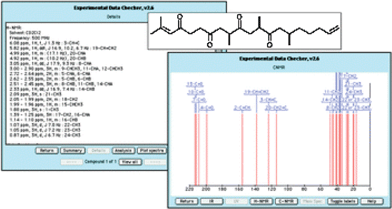 | ||
| Fig. 3 Experimental data checker. | ||
Thank you
We would like to express our thanks to everyone who has supported Journal of Materials Chemistry by contributing excellent papers and providing valuable and speedy referees' reports. The reputation of the journal and, ultimately its success or failure, is dependent on the work submitted by supportive authors and the reports provided by dedicated referees.As always, we welcome your suggestions as to how the journal might be improved or enhanced further. We wish you all every success in 2005.
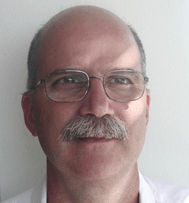 | ||
| Plate1 Maurizio Prato, Chairman, Editorial Board | ||
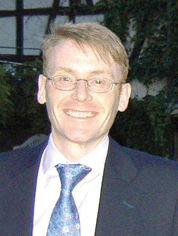 | ||
| Plate2 Graham McCann, Managing Editor | ||
References
- (a) M. Prato and G. F. McCann, J. Mater. Chem., 2004, 14, E1 RSC; (b) Peter Day, J. Mater. Chem., 2003, 13, xi Search PubMed.
- (a) W. A. MacDonald, J. Mater. Chem., 2004, 14, 4–10 RSC; (b) W. I. Milne, K. B. K. Teo, G. A. J. Amaratunga, P. Legagneux, L. Gangloff, J.-P. Schnell, V. Semet, V. Thien Binh and O. Groening, J. Mater. Chem., 2004, 14, 933–943 RSC; (c) D. Pauluth and K. Tarumi, J. Mater. Chem., 2004, 14, 1219–1227 RSC.
- (a) B. Dalton, S. Collins, J. Razal, E. Munoz, V. H. Ebron, B. G. Kim, J. N. Coleman, J. P. Ferraris and R. H. Baughman, J. Mater. Chem., 2004, 14, 1–3 RSC; (b) N. Tagmatarchis and M. Prato, J. Mater. Chem., 2004, 14, 437–440 RSC; (c) J. Kameoka, D. Czaplewski, H. Liu and H. G. Craighead, J. Mater. Chem., 2004, 14, 1503–1505 RSC; (d) J.-i. Yamada, J. Mater. Chem., 2004, 14, 2951–2953 RSC.
- Issue 14, 2004 (pages 2059–2354): J. Aizenberg, J. Livage and S. Mann, J. Mater. Chem., 2004, 14, E5 Search PubMed.
- Issue 4, 2004 (pages 437–780): C. N. R. Rao, J. Mater. Chem., 2003, 14, E4 Search PubMed.
- Issue 21, 2004 (pages 3071–3288): P. O'Brien and A. Sullivan, J. Mater. Chem., 2004, 14, E11–E15 Search PubMed.
- L. Zhai and R. D. McCullough, J. Mater. Chem., 2004, 14, 141–143 RSC.
- M. Aslam, L. Fu, M. Su, K. Vijayamohanan and V. P. Dravid, J. Mater. Chem., 2004, 14, 1795–1797 RSC.
- H. Strohm and P. Löbmann, J. Mater. Chem., 2004, 14, 138–140 RSC.
- J.-H. Park, H.-J. Choi, Y.-J. Choi, S.-H. Sohn and J.-G. Park, J. Mater. Chem., 2004, 14, 35–36 RSC.
- S. Lastella, Y. J. Jung, H. Yang, R. Vajtai, P. M. Ajayan, C. Y. Ryu, D. A. Rider and I. Manners, J. Mater. Chem., 2004, 14, 1791–1794 RSC.
- J. G. C. Shen, J. Mater. Chem., 2004, 14, 258–262 RSC.
- X. Jiang, Y. Wang, T. Herricks and Y. Xia, J. Mater. Chem., 2004, 14, 695–703 RSC.
- M. A. McLachlan, N. P. Johnson, R. M. De La Rue and D. W. McComb, J. Mater. Chem., 2004, 14, 144–150 RSC.
- I. Díaz, J. Pérez-Pariente and O. Terasaki, J. Mater. Chem., 2004, 14, 48–53 RSC.
- R. Viswanatha, S. Sapra, B. Satpati, P. V. Satyam, B. N. Dev and D. D. Sarma, J. Mater. Chem., 2004, 14, 661–668 RSC.
- G. F. McCann, J. Mater. Chem., 2004, 14, E9 RSC.
- S. E. Adams, J. M. Goodman, R. J. Kidd, A. D. McNaught, P. Murray-Rust, F. R. Norton, J. A. Townsend and C. A. Waudby, Org. Biomol. Chem., 2004, 2, 3067–3070 RSC.
| This journal is © The Royal Society of Chemistry 2005 |

